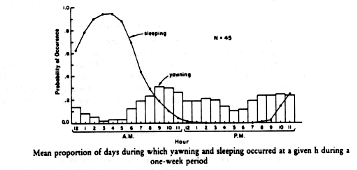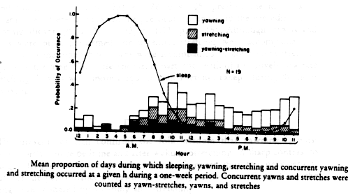Abstract : The temporal
relations among yawning, sleeping, and
stretching were investigated by having
undergraduate college students record the
occurrences of these behaviors during a one-week
period. Yawning was most frequent during the
hour before sleeping and after waking. In
contrast, stretching was common only during the
hour after waking. Concurrent yawning and
stretching were common but stretching was
accompanied more often by yawning than
vice-versa. The temporal proximity of yawning to
sleep and waking times is probably the basis for
yawning as a paralinguistic signal for
drowsiness. The role of contagious yawning in
synchronizing the behavior and physiological
state of a group is considered.
Introduction : Yawning is a common and
probably universal human behavior that is
performed throughout life (GESELL 1928). It is
characterized by gaping of the mouth accompanied
by a long inspiration followed by a shorter
expiration. Yawning is a stereotyped behavior
that is triggered by yet undefined physiological
states or released by witnessing yawns (PROVINE
1986). Even yawn-related stimuli such as
thinking about, or reading about yawns evoke
yawns (PROVINE 1986). Yawning is of clinical
importance because it is symptomatic of
pathology including brain lesions and turnors,
hemorrhage, motion sickness, chorea, and
encephalitis (BARBIZET 1958; GRAYBIEL &
KNEPTON 1976; HEUSNER 1946; JURKO1975). In
addition, it is therapeutic in preventing
post-operative respiratory complications
(BARTLETT 1971; CAHILL 1978) and in adjusting
the air pressure in the middle ear (LASKIEWICZ
1953). Despite the promirience of yawning in
everyday behavior, yawning as recelved little
attention in the scientific literature. There is
much popular opinion but little empirical
evidence about when we yawn, why we yawn, what
function yawning may serve, and what
environmental circumstances modulate yawning
rate.
Yawning is commonly associated with
drowsiness, boredom and low levels of arousal.
Humans, for example, yawn when participating in
lengthy, uninteresting or repetitive tasks
(KATAOKA 1975; KisHiDA 1973; SAKAI &
TAKAHASHI 1975), and yawn more when observing
uninteresting Chan interesting stimuli (PROVINE
& HAIMERNIK 1986). Beliefs about the
relation between sleepiness and yawning are
based upon folk wisdom and everyday observations
to which science has had littie to add. Texts on
sleep occasionally mention the prominence of
yawning in drowsy people but typically cite only
unrelated or general references on yawning such
as BARBIZET (1958) or HEUSNER (1946). Stretches
often accompany yawns in humans and other
animals. Neurological evidence for a correlation
between yawning and stretching comes from case
reports of human hemiplegics who are unable to
separate the behaviors. Such individuals often
perform associated stretching movements of
otherwise paralyzed body parts during yawns
(WALSHE 1923). A pharmacological basis for a
yawn-stretch relationship comes from the
observation that drugs chat produce yawning also
produce stretching in a variety of animais
(DOURISH & COOPER 1987; GESSA CC al. 1967;
YAMADA & FURUKAWA 1980).
The present report explored the relation
between yawning, stretching, and sleeping.
Particular attention was devoted to the
concurrence of yawning and stretching and the
correlation of both behaviors to bed and waking
times. The study of humans permitted the use of
a self-report procedure that is unusual in
ethological rescarch. Each subject recorded his
or her yawning, stretching, and sleeping times
in log-books during one week. This procedure
enabled a total of over one subject-year of data
to be collected from 64 participants engaged in
normal life activities. An alternative
procedure, the direct 24-h per day observation
of each subject would have required the
long-term committrient of a team of observers
whose presence may have biased the results; the
social sanctions against yawning in the presence
of others are well known. The self-report
procedure has other advantages. Outside
observers but not the behaving subjects have a
problem in discriminating between the subject's
own yawns, sighs, stretches, and ambiguous or
shielded movements. The test-retest reliability
of self-reported yawn frequency and duration in
a laboratory setting is already documented
(PROVINE 1986). To decrease the obtrusiveness of
the record keeping procedure, subjects recorded
yawns or stretches when they occurred instead of
logging behavior every hour. This was also a
precaution against yawns being cued hourly by
the act of record keeping; even the thought of
yawning is sufficient to trigger yawns (PROVINE
1986). To minimize possible individual
differences in the accuracy of subject's record
keeping and to furcher reduce the possible
effects of cue-induced yawning, the results
compiled from the log-books were reported as the
probability, not the frequency, of yawning or
stretching petrhourly interval.
[...]
Discussion : The present research
confirms the folk wisdom that yawning is most
frequent shortly before bedtime and after
waking. Stretching, in sharp contrast to
yawning, is frequent only shortly after waking.
There are, thus, two peak periods per day for
the performance of yawning, but only one for
stretching. Only the morning peak is shared by
yawning and stretching. The temporal patterning
data suggest a possible basis for the emergence
of the yawn, but not the stretch, as a gesture
or paralinguistic signal for drowsiness. Yawns
are related to the drowsiness experienced both
before and after waking while stretching
corresponds only to that after waking. The
gestural significance of stretching, if any, is
less obvious than that of yawning. However, the
frequent stretching immediately after waking and
the common practice of stretching before
physical activicy is consistent with stretching
as a signal for the preparation for action.
The neurological and pharmacological studies
cited earlier suggest similar or shared
mechanisms for yawning and stretching. The
prescrit report of frequent, concurrent yawning
and stretching and a similar peak time of
occurrence during the hour after waking also
indicate a relation. However, there is aiso
evidence for at least partial autonomy: Whereas
47 % of stretches were accompanied by a yawn,
only 11 % of yawns were accompanied by a
stretch. Also, stretching shared the post-waking
but not the pre-sleeping peak of yawn activity.
The above evidence suggests that human yawning
is not simply the facial manifestation of a
generalized stretch response. Stretching after
waking may be a useful warm-up for a person
arousing from the immobility of sleep. Powerful
stretching movements have major, widespread
physiological consequences, including increases
in the puise rate, blood pressure, and blood
flow to the muscles and other body parts, and
increases in the flexibility of the muscles and
l'oints (McARDLF et al. 1981; SHEPHARD
1982).
The physiological consequences of yawning are
largely unknown. Yawning shortly before sleeping
and after waking may be either a maneuver to
increase alertness or brain function of a drowsy
organism or to depress alertness and hasten or
otherwise prepare us for sleep. Only a few
hypotheses about yawn function have been
evaluated. No support has been found for the
popular assumptions that yawning is either a
response to, or somehow adjusts blood levels Of
C02 or 02 (PROVINE et al. 1986, 1987). Yawning
rate is neither facilitated nor depressed by
breathing gases with elevated levelS of C02 or
02, yawning is also unaffected by vigorous
exercise (PROVINE et al. 1986, 1987). In
addition, the absence of a significant
correlation between yawn duration and inter-yawn
interval indicates that infrequent yawners do
not cornpensate by performing longer than normal
yawns and vice versa (PROVINE 1986).
Further evidence against the yawn as mainly a
respiratory act comes from tests of the
fixedness of the routes of inhalation and
exhalation during yawning (PROVINE 1986; PROVINE
et al. 1986, 1987). During a yawn, inhalation
and exhalation occur primarily through the mouth
and this basic pattern is highly inflexible. It
is very difficult, if not impossible, for most
people to perform a satisfying yawn with their
lips taped shut even though they are free to
respire through their nose. Yawning does not
have the flexibility of normal breathing which
can bc accomplished with equal facilicy through
nose or mouth. However, oral inhalation by
itself is insufficient to produce a satisfactory
yawn if the jaws are immobilized. Subjects
attempting to yawn with clenched teeth often
report the unpleasant sensation of being stuck
in mid-yawn and being unable to perform a
satisfying yawn although they could inhale and
exhale through their teeth. Perhaps the gaping
of the jaws during yawning produces a vigorous
facial stretch thar increases cerebral blood
flow or alters some other intracranial
activitv.
One of the most striking and curious features
of yawning is the tendency to yawn after
visually observing a yawn (PROVINE 1986). Even
reading or thinking about yawning evokes yawns
(PROVINE 1986). The range and potency of
yawnproducing sensory stimuli contribute to the
spread of yawning through a group. The present
study indicated that yawns, and therefore the
intrinsic and/or extrinsic stimuli that evoked
them, were most common shortly before bedtime
and after waking. The yawning that evolved as a
response to the internal body state at such
times has acquired a secondary signalling
function that can synchronize the behavior of a
group. The yawning of an individuail rnay
trigger a chain reaction of yawning in
witnesses. The resulting communal yawning may
signal bedtime for a group as it did for the
Bakairi of Central Brazil in the presence of
their first European visitor. "If they seemed to
have had enough of ail the talk, they began to
yawn unabashedly and without placing their hands
before their mouths. That the pleasant reflex
was contagious could not be denied. One after
the other got up and left until I remained with
my dujour (STEINEN, cited in EIBL-EIBESFELDT
1975, p. 163). If yawning affects the physiology
of the yawner, the contagion of yawning may
synchronize the physiological as well as the
behavioral state of a group.




